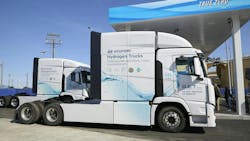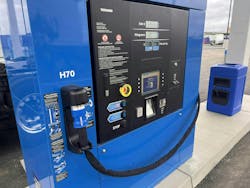Hyundai has been in on hydrogen since 1998, when it launched a fuel cell department. A consumer FCEV called the ix35 came 15 years later and the Nexo in 2018. Hyundai, which is based out of South Korea, has made hydrogen a big part of its decarbonization road map, and at the 2019 North American Commercial Vehicle Show in Atlanta, it announced its intention to bring hydrogen to trucking with the HDC-6 NEPTUNE concept tractor-trailer in conjunction with its Translead business.
The futuristic bulbous design was not meant to be, as the hydrogen truck being tested in the U.S., the Hyundai Xcient, has a classic cabover look.
First deployed in Switzerland, where 23 fleets accrued 3 million miles from 2020 to 2022, the Xcient offers an average range of around 430 to 450 miles per fueling. Overall, Hyundai has as many as 200 Xcients deployed in eight key global markets. The company also announced a Level 4 autonomous version is being developed with Plus.
In the U.S., Hyundai’s largest public deployment is through the NorCAL ZERO Project, where 30 6x4 Xcients serve G.E.T Freight Corp. in the Bay Area. They refuel at the recently opened FirstElement Fuel station near the Port of Oakland, the first publicly available refueling station for commercial FCEVs. What ends up in the truck is gaseous hydrogen, but FirstElement transports the fuel in liquid form, which allows for 10 times more hydrogen hauled in a tanker, with far more being able to be offloaded at the station. A special cryopump was developed to efficiently convert the hydrogen.
The gaseous fuel is dispensed at 700 bar, equivalent to around 10,000 psi, allowing for refills in as quick as 10 minutes.
Read more: Honest insights from a Nikola Tre FCEV owner after half a year
“The recipient outfitted on most of the trucks out there today cannot receive hydrogen at such a fast flow rate,” noted Shane Stephens, founder and chief development officer of FirstElement. “Therefore, we expect refueling to take place at between 20 and 30 minutes initially, and once the trucks are outfitted with high flow recipients, we will be able to fill them in under 10 minutes.”
With a range well over one-third higher than most Class 8 BEVs, and similar refuel times to diesel trucks, Hyundai believes hydrogen has a place in transportation’s zero-emission future.
“The elegant solution toward electrification beyond [BEVs] is hydrogen,” said Jim Park, the Hyundai SVP heading the N.A. hydrogen program.
And like pure electric trucks, Park said FCEVs have the maintenance advantage of fewer moving parts and less required lubrication though venting the gas and keeping up on coolant PMs will be important.
“For the maintenance shop, what you basically need is an active ventilation system, so there needs to be hydrogen sniffers installed in the shop.
Benjamin Happek, Hyundai senior research engineer, added that shops will need an active ventilation system and hydrogen sniffers, or leak detectors.
“If hydrogen is detected, it has to be evacuated,” Happek said. “And this is typically done via a roof hatch that opens automatically, and fans will evacuate the air out of the out of the building. Hydrogen disperses very rapidly so it shouldn’t be a big concern.”
He added that because hydrogen flames are invisible to the naked eye, an infrared camera should be set up.
Before FCEVs can scale to where shops need to put holes in their roofs, the cost of hydrogen itself will have to come down. The U.S. Department of Energy Hydrogen Shot Initiative aims to bring the cost of green hydrogen down to $1/kg by 2031, or 80% of the 2021 price. That is processing cost, not the price at the pump which is far higher.
“The harsh reality today in California, because of limited producers, is hydrogen probably averaging over $30/kg,” Park said. “And that is a very difficult pill to swallow for consumers.”
He said the current testing of FCEVs and scaling of infrastructure eventually can “drive a more competitively priced field.”
About the Author

John Hitch
Editor-in-chief, Fleet Maintenance
John Hitch is the award-winning editor-in-chief of Fleet Maintenance, where his mission is to provide maintenance leaders and technicians with the the latest information on tools, strategies, and best practices to keep their fleets' commercial vehicles moving.
He is based out of Cleveland, Ohio, and has worked in the B2B journalism space for more than a decade. Hitch was previously senior editor for FleetOwner and before that was technology editor for IndustryWeek and and managing editor of New Equipment Digest.
Hitch graduated from Kent State University and was editor of the student magazine The Burr in 2009.
The former sonar technician served honorably aboard the fast-attack submarine USS Oklahoma City (SSN-723), where he participated in counter-drug ops, an under-ice expedition, and other missions he's not allowed to talk about for several more decades.

